I have the x, y co-ordinates of a point on a rotated image by certain angle. I want to find the co-ordinates of the same point in the original, non-rotated image.
Please check the first image which is simpler:
UPDATED image, SIMPLIFIED:

OLD image:

I have the x, y co-ordinates of a point on a rotated image by certain angle. I want to find the co-ordinates of the same point in the original, non-rotated image.
Please check the first image which is simpler:
UPDATED image, SIMPLIFIED:

OLD image:

Let's say the first point is A, the second is B and the last is C. I assume you have the rotation matrice R (see Wikipedia Rotation Matrix if not) et the translation vector t, so that B = R*A and C = B+t. It comes C = R*A + t, and so A = R^1*(C-t).
Edit: If you only need the non rotated new point, simply do D = R^-1*C.
First thing to do is defining the reference system (how "where the points lies with respect to each image" will be translated into numbers). I guess that you want to rely on a basic 2D reference system, given by a single point (a couple of X/Y values). For example: left/lower corner (min. X and min. Y).
The algorithm is pretty straightforward:
Getting the new defining reference point associated with the rotated shape (min. X and min. Y), that is, determining RefX_new and RefY_new.
Applying a basic conversion between reference systems:
X_old = X_new + (RefX_new - RefX_old)
Y_old = Y_new + (RefY_new -
RefY_old)
----------------- UPDATE TO RELATE FORMULAE TO NEW CAR PIC
RefX_old = min X value of the CarFrame before being rotated.
RefY_old = max Y value of the CarFrame before being rotated.
RefX_new = min X value of the CarFrame after being rotated.
RefY_new = max Y value of the CarFrame after being rotated.
X_new = X of the point with respect to the CarFrame after being rotated. For example: if RefX_new = 5 with respect to absolute frame (0,0) and X of the point with respect to this absolute frame is 8, X_new would be 3.
Y_new = Y of the point with respect to CarFrame after being rotated (equivalently to point above)
X_old_C = X_new_C(respect to CarFrame) + (RefX_new(CarFrame_C) - RefX_old(CarFrame_A))
Y_old_C = Y_new_C(respect to CarFrame) + (RefY_new(CarFrame_C) - RefY_old(CarFrame_A))
These coordinates are respect to the CarFrame and thus you might have to update them with respect to the absolute frame (0,0, I guess), as explained above, that is:
X_old_D_absolute_frame = X_old_C + (RefX_new(CarFrame_C) + RefX_global(i.e., 0))
Y_old_D_absolute_frame = Y_old_C + (RefY_new(CarFrame_C) + RefY_global(i.e., 0))
(Although you should do that once the CarFrame is in its "definitive position" with respect to the global frame, that is, on picture D (the point has the same coordinates with respect to the CarFrame in both picture C and D, but different ones with respect to the global frame).)
It might seem a bit complex put in this way; but it is really simple. You have just to think carefully about one case and create the algorithm performing all the actions. The idea is extremely simple: if I am on 8 inside something which starts in 5; I am on 3 with respect to the container.
------------ UPDATE IN THE METHODOLOGY
As said in the comment, these last pictures prove that the originally-proposed calculation of reference (max. Y/min. X) is not right: it shouldn't be the max./min. values of the carFrame but the minimum distances to the closer sides (= perpendicular line from the left/bottom side to the point).
------------ TRIGONOMETRIC CALCS FOR THE SPECIFIC EXAMPLE
The algorithm proposed is the one you should apply in any situation. Although in this specific case, the most difficult part is not moving from one reference system to the other, but defining the reference point in the rotated system. Once this is done, the application to the non-rotated case is immediate.
Here you have some calcs to perform this action (I have done it pretty quickly, thus better take it as an orientation and do it by your own); also I have only considered the case in the pictures, that is, rotation over the left/bottom point:
X_rotated = dx * Cos(alpha)
where dx = X_orig - (max_Y_CarFrame - Y_Orig) * Tan(alpha)
Y_rotated = dy * Cos(alpha)
where dy = Y_orig - X_orig * Tan(alpha)
NOTE: (max_Y_CarFrame - Y_Orig) in dx and X_orig in dy expect that the basic reference system is 0,0 (min. X and min. Y). If this is not the case, you would have to change this variables.
The X_rotated and Y_rotated give the perpendicular distance from the point to the closest side of the carFrame (respectively, left and bottom side). By applying these formulae (I insist: analyse them carefully), you get the X_old_D_absolute_frame/Y_old_D_absolute_frame that is, you have just to add the lef/bottom values from the carFrame (if it is located in 0,0, these would be the final values).